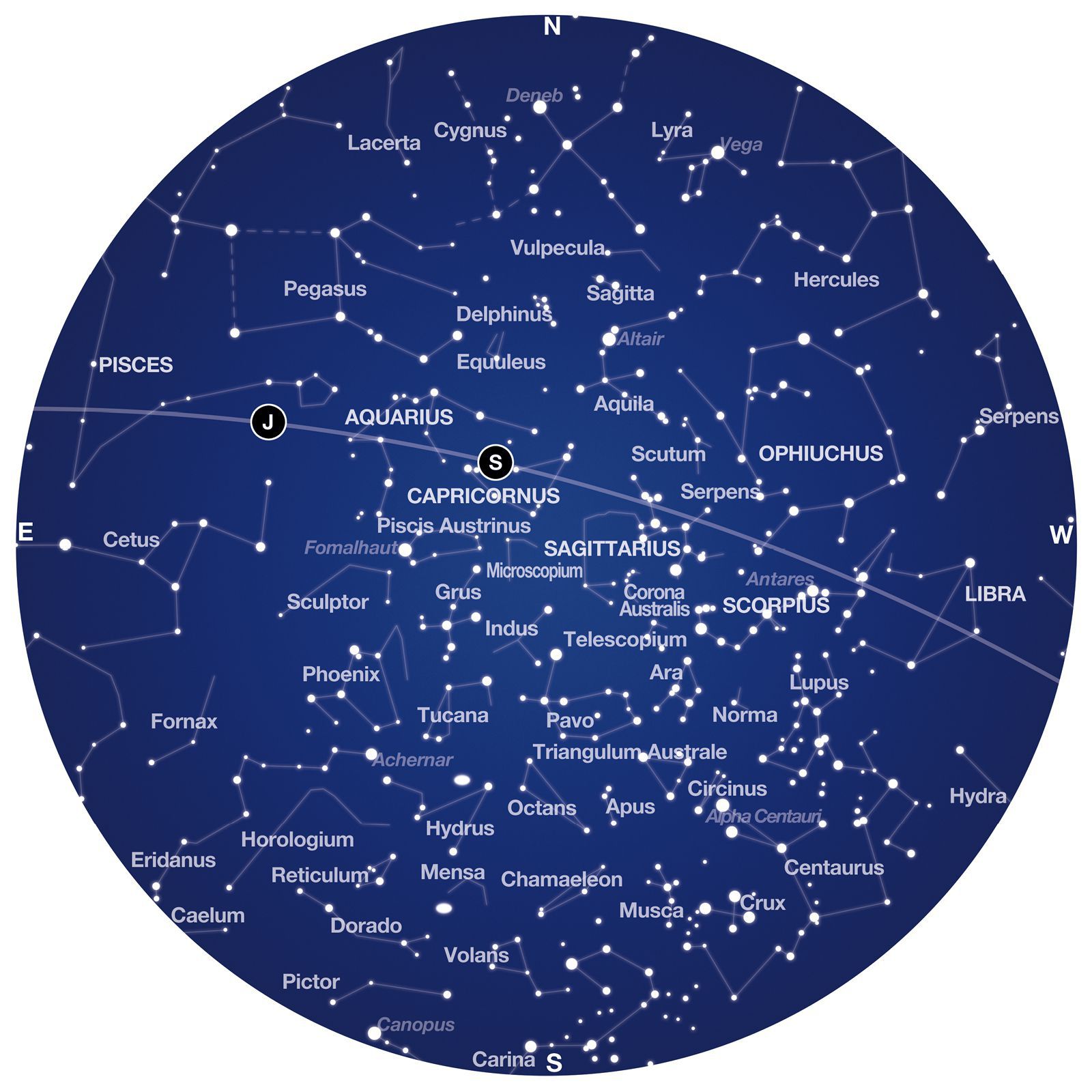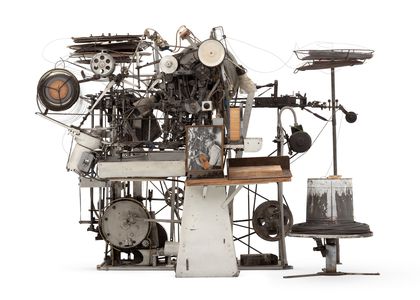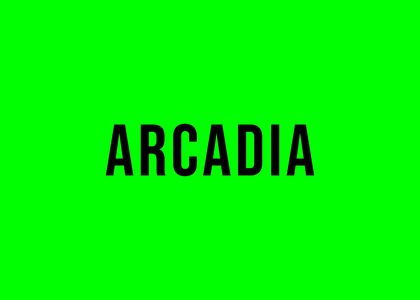
Monthly sky maps from the 2022 Australasian Sky Guide published by Powerhouse Publishing.
What’s in the sky this October?
Please remember that Daylight Saving Time starts at 2am on October 2 in NSW, ACT, Victoria, Tasmania and South Australia. Put your clocks forward one hour. If you rely on a smartphone the adjustment is automatic – but now you’ll know why an hour of the night has gone missing.
Constellations
Constellations are groups of stars that represent mythological figures, fanciful beasts or maybe old scientific instruments. For millennia they have been used as a tool to share significant cultural stories and to track the passage of the weeks and months. Today, they also help astronomers delineate portions of the sky and locate astronomical objects. In October, in the early evening, these constellations dominate the sky:
- Crux – or the Southern Cross as we all know it, is in the south-east in October and upside down each evening. Around midnight it reaches its lowest point in the sky, very close to the southern horizon where it will be difficult to spot unless you have an unobstructed view due south.
- Scorpius – this is your final chance this year to spot the Scorpion as he dips into the western horizon. If you have a very dark sky (and the Moon is not up) you will see the Milky Way, our galaxy, from which Scorpius appears to dangle, hanging by his hooked tail as he descends.
- Capricornus – an odd creature composed of a goat’s head and forefeet joined to the tail of a fish. Like Scorpius Capricornus is a zodiac constellation – one through which the Sun passes – and amongst the most ancient of constellations. The Greeks identified him with Pan, their god of the countryside. He was a naughty little goat who chased women and seduced them. One attempted conquest failed when his target leapt into a river and disguised herself as a bunch of reeds. On grabbing the reeds Pan heard the wind blowing tunefully through them – and the Pan flutes were born.
- Grus – just to the south-east from Capricornus is a bright star. This is Fomalhaut and it represents the mouth of Pisces Austrinus, or the Southern Fish. But I only mention this because it’s a guide to the constellation of Grus, the Crane. A modern constellation, dating from the 1500s (well, relatively modern!) it looks to me more like a scimitar with a great curving blade. It’s one of my favourite Spring constellations.
- Cygnus – the Swan is low by the northern horizon in October. Stories connected to Cygnus are somewhat convoluted. One of them tells us Zeus disguised himself as a Swan while on his way to seduce Nemesis, the nymph. But she was totally uninterested. Nemesis instead produced an egg from which hatched the beautiful Helen of Troy. The tail of Cygnus is marked by the bright star Deneb. This blue-white star is a giant and over 100 times the size of our Sun. Even at its vast distance of 3000 light years from us it is still amongst the brightest stars in the sky. If it were as close as Alpha Centauri (the closest star to the Sun at just 4.5 light years away) it would cast shadows at night!
Planets
This month Saturn is our evening planet and Mars our morning planet. Jupiter is visible all night for much of the month. It is best in the evenings all month but also visible in the morning twilight until the middle of October.
If you have trouble identifying planets from stars (and Saturn doesn’t stand out this month) the Moon comes to your aid – see below.
The best time to view will be soon after sunset or an hour or so before sunrise.
- Jupiter – the King of the Planets is still very bright (having been at opposition late in September) and hard to miss in the eastern and north-eastern sky each evening. It is a bright yellowish-white colour and sits in the constellation of Pisces this month.
- Saturn – the Ringed Planet is quite faint this month and not easily identified. It sits in Capricornus all month and precedes Jupiter in its passage across the sky by about two full handspans (with your arm out at full length). If you find Saturn is difficult to identify look on the evening of the 5th when the gibbous Moon sits just above and left of the planet – binoculars will help.
- Mars – the Red Planet is in the northern sky in Taurus and easily identified by its colour.
In my last Sky Guide (July) I noted the bright appearance of the twilight sky, probably due to January’s volcanic eruption in Tonga. In recent weeks I’ve had the chance to get away from Sydney’s bright lights and, when it wasn’t raining, I’ve noticed the glow is decreasing and the sky is gradually returning to its normal state as the dust falls out of the stratosphere.
Moon
First Quarter is on Monday 3rd
Full Moon is on Monday 10th
Last Quarter is on Tuesday 18th
New Moon is on Tuesday 25th
Let the Moon be your guide to the planets this month: On October 5th a gibbous Moon is above & left of Saturn. On October 8th the gibbous Moon is now just above Jupiter. For Mars look during the morning twilight (around 5-6am) in the middle of the month when the gibbous Moon sits below & left (Oct 15) and below & right (Oct 16) of the Red Planet.
Saturday October 1st is International Observe the Moon Night. Join the world on this Saturday to catch the Moon in its waxing crescent phase. Use your binoculars to spot craters, oceans and seas. If you have a good telescope and steady seeing (by which I mean the Moon is not shimmering like a mirage) try using a high magnification and you’ll feel like an astronaut flying over the lunar surface!
Deep Sky
Explore the universe through your binoculars or a telescope and take in some of the gems of the October sky. These look at their best with no Moon in the sky – so try before midnight after October 15:
- The Magellanic Clouds & 47-Tuc – with binoculars look south for our neighbouring galaxies the Large Magellanic Cloud (LMC) and the Small Magellanic Cloud (SMC) both around 200,000 light years away from us. You will see fields of stars and maybe a hazy nebula. Beside the SMC the fuzzy, dandelion-like star you see is in fact the globular cluster 47-Tucanae, better known simply as “47-Tuc”. Just 16,000 light years away it’s a ball-shaped group of stars on the edge of our galaxy. It contains hundreds of thousands of ancient stars most of them several times older than our Sun.
- Turn your binoculars northwards – to spot little Delphinus, the dolphin constellation, and then scan slowly along the Milky Way to spot clusters & nebulae galore.
- Jupiter & Saturn – are targets for a telescope if you have one. Watch Jupiter’s Moon Io play hide & seek with the planet (predictions are available from the Sky &Telescope tool and then turn to Saturn to marvel at his rings.
- The Ring & Lagoon nebulae – with a larger telescope, one with tracking motors and computer control, you can easily locate the Ring nebula, M57, a ‘smoke ring’ blown off by a dying star. And finally, under Moon-less and dark country skies, dive into the Lagoon nebula…and contemplate the grandeur and timeliness of our vast and surprising universe.
Other Events
October 23 marks the bicentenary of the birth of Friedrich Wilhelm Gustav Sporer who studied sunspots and noticed fewer sunspots had been recorded between 1645 and 1715. This is now called the Maunder Minimum – a period of particularly cold weather in the northern hemisphere. He noticed another gap in the sunspot record between 1460 and 1550 and this one is now known as the Sporer minimum. He died in 1895.
On October 25 there is a partial solar eclipse visible from Europe, the Middle East, north Africa and western Asia, but not from Australia. However, we get to see a total lunar eclipse on November 8 – don’t miss it!
On October 16 the spacecraft Lucy passes Earth on its long roundabout trip to the Trojan asteroids near Jupiter, arriving there in 2027.
Learn More
- Purchase the 2023 Australasian Sky Guide by Dr Nick Lomb, featuring an annual report of what’s in the sky and the latest astronomical findings. Produced by Powerhouse Publishing.
- View the October StarMap which shows the stars, constellations and planets visible in the night sky from anywhere in Australia
- Check out these resources for getting started


